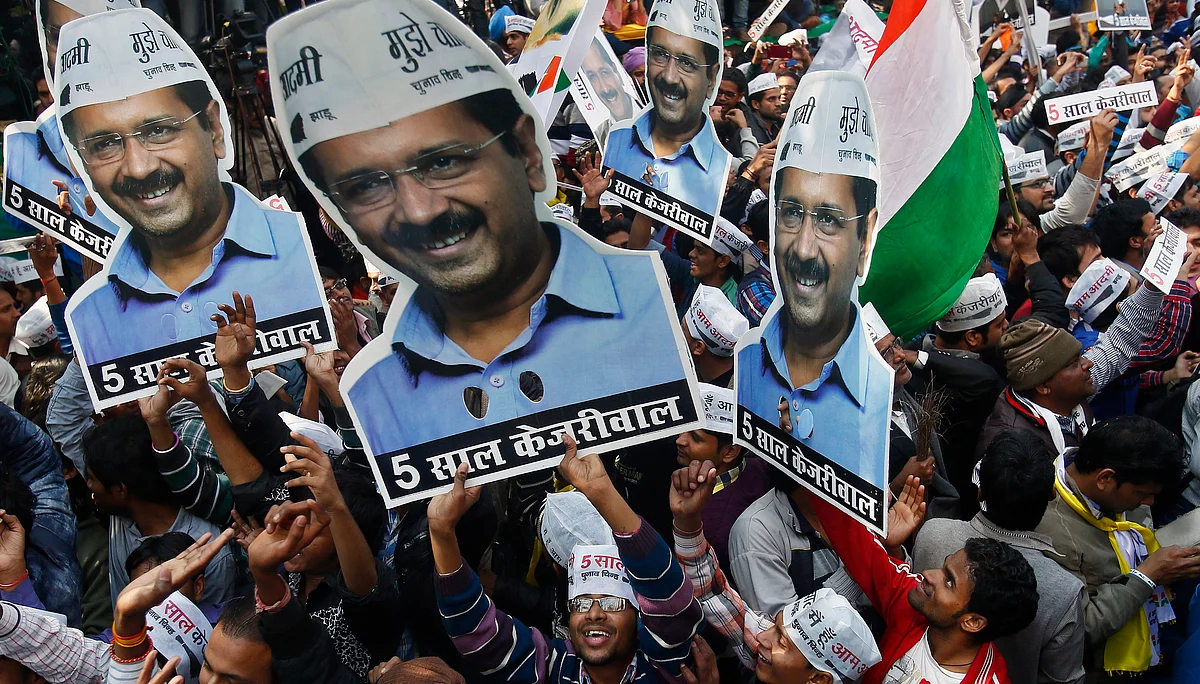Is Mufflerman Losing the Capital Plot? #100Daysof Kejriwal
Arvind Kejriwal had made some monumental promises. But how many has he delivered on so far?

advertisement
Much like Prime Minister Narendra Modi, Delhi Chief Minister Arvind Kejriwal too has been under scrutiny. The populace and the polity have been keeping a hawk’s eye on this maverick politician who promised to change the face of Delhi and its politics.
To what extent has Kejriwal succeeded in the last 100 days? Is his story anything to write home about?
Of Promises Kept and Hidden Clauses Revealed
A populist Aam Aadmi Party (AAP) manifesto promised the reintroduction of the Janlokpal Bill, full statehood to Delhi, free WiFi, 15 lakh CCTV cameras, slashing power tariffs by 50 percent and free water, among others.
The Bijli-Paani Promise
In Arvind Kejriwal’s short-lived 49-day government -- his first stint at government -- slashed electricity bills left everyone stumped.
Kejriwal had people eating out of his hands and despite his arbitrary exit from the Delhi Assembly just 49 days into tenure, he was voted back to power this year with a crushing majority. And just a fortnight into assuming office -- the technicalities of its execution aside -- power tariffs in the city were down by half for consumption upto 400 units.
Like the pledge to halve power tariffs, Kejriwal’s promise of free “lifeline water” provides for 20 kilolitres (kl) of free water per month to every household with a metred water connection.
And these are two promises which are likely to cost the exchequer to the tune of Rs 1,700 crore.
Read Red Herring Prospectus Carefully
While the city rejoiced at the prospect of cheaper power and free water, the offer holds good only for those who consume within the specified limit.
This means, if your power consumption is 401 units, you’ll pay for the entire 401 units instead of the additional one unit. Likewise, if your water consumption is 20.1 kl, you can’t avail of the free lifeline water scheme.
At the same time, while 27 percent of the power generated falls prey to power pilferage, 25 percent of the city’s households have no water pipelines or connections at all -- factors that Kejriwal hasn’t assessed or acted upon yet.
The Anti-Bhrashtachaar Rant
With much pomp and show, Arvind Kejriwal re-launched the anti-corruption helpline early April.
Kejriwal’s penchant for catching “corrupt” officers red-handed was only too obvious even before he assumed office in 2013.
This time round too, he revived the helpline that was meant to aid citizens who until now, had failed to circumvent red-tape in government offices. And we daresay, the helpline has got a thumping response from the masses.
But that is just as far as it goes.
Miles to Go Before He Sleeps
If one were to compare Arvind Kejriwal’s style of governance in 2013 and now, his sudden exit from the Assembly notwithstanding, the CM needs to desperately up his ante, this time.
Before we came to power, we had promised the people of Delhi certain things. We have already lived up to several of those promises and in due course, we will fulfill all other promises we have made. We are not like other governments.
– Senior AAP Leader
Education for All?
In the 70-point manifesto, Kejriwal had made a very tall promise of setting up 500 new schools and 20 new colleges. What he has instead done is haul up 200 private schools for “overcharging” students. And Delhi’s schools are not amused by this baseless allegation.
Every single private school in the city has a managing board which comprises representatives from the Directorate of Education (DoE). When schools put out a fee rise proposal, it is first cleared by the Parent-Teacher body and then it is cleared by the DoE, before it is implemented. So if the Delhi government is making such allegations, it must first conduct a thorough inspection and then penalise schools if it finds something wrong.
– Ameeta Wattal, Chairperson of the National Progressive Schools’ Conference
Kejriwal’s deputy Manish Sisodia who, as the education minister, had done a stellar job of sending out inspection teams to government schools in their last stint and charting out a concrete plan to uplift these schools, has remained bogged down by firefighting within the party.
Promises on the Backburner
Arvind Kejriwal had also harped on the issue of full statehood for Delhi, quadrupling the number of public hospital beds, recruiting 4,000 doctors and 15,000 paramedics, building two lakh public toilets, investing in public transport and abolishing contract labour.
However, the city, and by extension the country, has only been witness to disarray and pandemonium. Kejriwal’s Transport Minister Gopal Rai’s plans of procuring 4,000 new DTC buses and preventing e-rickshaw cartels from taking shape are still in the pipeline.
His Law Minister, Jitender Tomar, who was entrusted the responsibility of reassessing measures for women’s safety, has been mired in controversy.
Then there was the hype over the free Wi-Fi plan, the modalities of which are still being worked out. Now, as government sources claim, the project is not likely to see the light of the day till another year.
Needless to say, the AAP government’s progress has provided the opposition much fodder for critique.
This government is a complete failure. It is a government of confrontation and not of development. It has taken on the media, the LG and all of society. They have ridiculed the people and believe in being dictatorial.
– Satish Upadhyay, Delhi BJP Chief
Arvind Kejriwal exhibited much promise when he was voted back to power in Delhi with an unprecedented majority of 67 seats in an assembly of 70.
What the AAP Delhi government seems to be doing now is taking that mandate for granted.